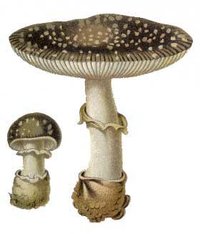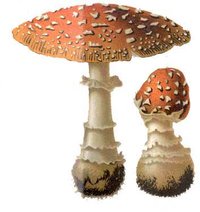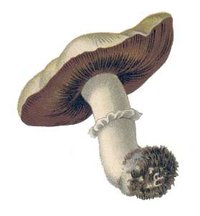Fungus
|
|
| Fungi | ||||
|---|---|---|---|---|
| Missing image Fungus_on_log.jpg Orange parasitic fungus Orange parasitic fungus. | ||||
| Scientific classification | ||||
| ||||
| Divisions | ||||
|
Chytridiomycota |
Fungi (singular: fungus) are a major group of living things, originally considered plants but now treated as the separate kingdom Fungi. They occur in all environments on the planet and include important decomposers and parasites. Parasitic fungi infect animals, including humans, other mammals, birds, and insects, with consequences varying from mild itching to death. Other parasitic fungi infect plants, causing diseases such as butt rot and making trees more vulnerable to toppling. The vast majority of vascular plants are associated with mutualistic fungi, called mycorrhizae, which assist their roots in absorption of nutrients and water.
| Contents |
Human consumption
Some fungi are popular as food: button mushrooms, oyster mushrooms, shiitake mushrooms, puffballs, morels, truffles, porcini (King bolete) and Mexican Corn smut are examples. Some mushrooms are also ingested for their hallucinogenic properties, both recreationally and religiously (as entheogens). Many other mushrooms are extremely poisonous (see Mushroom poisoning). While not every mushroom is dangerously poisonous, most simply aren't large or tasty enough to be eaten. Wild mushrooms should not be eaten unless identifed by an expert. However, even very knowledgeable persons occasionally misidentify wild mushrooms, with sometimes fatal consequences. Many fungi are used in the production of foods such as breads, alcohol, and certain cheeses.
Structure
Fungi can be divided into two basic morphological forms, yeasts and hyphae. Yeasts are unicellular fungi which reproduce asexually by blastoconidia formation (budding) or fission. Hyphae are multi-cellular fungi which reproduce asexually and/or sexually. Aerial hyphae often produce asexual reproduction propagules termed conidia (synonymous with spores)
Fungi have a vegetative body called a thallus or soma, composed of one-cell-thick filaments termed hyphae (singular: hypha). The hyphae typically form a microscopic network within the substrate (food source) called the mycelium, through which food is absorbed. Usually the most conspicuous part of any fungus are its fruiting bodies—reproductive structures that produce spores.
Division of hyphae into cells is either incomplete, in which case the hyphae are called septate and the dividing walls are called septa (singular: septum), or absent, in which case the hyphae are called coenocytic. Fungi generally have cell walls made from chitin, hemicellulose, lipids, protein and other materials. The hyphae may be modified to produce highly specialized cellular-scale structures. For instance, fungi that parasitize plants grow haustoria that pierce the plant cells and digest substances on the inside; some soil-dwelling fungi actually trap roundworms and other small animals.
Most chytrids, which are generally considered the most primitive group of fungi, do not form hyphae and instead grow directly from spores into multinucleate sporangia. A few other fungi have reverted from a mycelial to a unicellular organization. These are the yeasts, which belong among the ascomycetes, and the Microsporidia, a group of reduced parasites whose relationships to the other fungi are uncertain.
Reproduction
Sexual
Fungal mycelia are typically haploid. When mycelia of different mating types meet, they produce two multinucleate ball-shaped cells, which form a mating bridge. The result is that nuclei move from one mycelium into the other, forming a heterokaryon (meaning different nuclei). This is called plasmogamy. Actual fusion to form diploid nuclei is called karyogamy, and may not occur until sporangia are formed.
In the Zygomycota, the heterokaryon produces multiple fruiting bodies, in the form of minuscule stalks with sporangia at the end. Most ascomycetes produce fruiting bodies called ascocarps, composed entirely of hyphae. These are usually bowl- or cup-shaped, but some have sponge-like structures. On the inside of the cup, each hypha terminates in an ascus, which produces eight spores.
In the Basidiomycota, the heterokaryon produces a new mycelium which may live for years without producing a fruiting body. The familiar mushrooms are examples of these. They usually have a stalk, composed mainly of hyphae, and a cap, under which there are sheetlike structures called gills. On the surface of each gill there are numerous hyphal cells called basidia, with several spores on the end of each.
Asexual
Fungi may also reproduce asexually, for instance through the production of spores called conidia (Greek for dust), which form at the tips of specialized hyphae called conidiophores. In some fungi sexual reproduction has been lost, or is unknown. These were originally grouped as the form division Deuteromycota, or the Fungi imperfecti, since the means of sexual reproduction was the primary means of classifying fungi, but are now classified with their ancestral group.
Except among the chytrids, where spores are propelled by a posterior flagellum, all fungal spores are non-motile. They develop into new mycelia, which invade some substrate and repeat the life cycle. These may become very large, often several square meters in size; fairy rings are an example.
Nutrition and ecology
Fungi are heterotrophic, that is they get their energy by breaking down organic molecules, and cannot synthesize organic molecules from inorganic substances (as plants do). They feed by secreting exoenzymes into the surrounding substrate. Exoenzymes act like the digestive enzymes of animals, breaking apart large organic molecules, but function outside the organism. The smaller organic molecules are then absorbed by the fungal cells. Fungi are also considered to be osmiotrophs, a particular mode of nutrition.
Two main ecological niches occupied by fungi are that of the decomposer (detritivore) or saprophyte, and that of the parasite. The only difference between detritivorous and parasitic fungi is that the latter grow on living organisms, while the former grow on dead organisms. Many decomposer fungi live as mycorrhizae, in mutualistic relationships with plants. Some of the detritivorous fungi are also considered "facultative parasites," growing on weakened or dying organisms. Among the parasitic fungi are species which are insectivorous or helminthivorous (worm-eating). Some insectivorous species produce sticky substances which trap insects, while the worm-eating fungi produce substances which drug and immobilize worms, which are then consumed.
Some fungi, usually ascomycetes, live as lichens. A lichen is a very close mutualistic relationship between a fungus and a photosynthetic microorganism, usually a cyanobacterium or green alga. A lichen behaves in so many ways like a single organism that lichens are actually given species names.
Pathogenic species
Fungal diseases include:
Fungal infections may also be a factor in causing specific replant disease.
In general, humans have a high level of innate immunity to fungi and most of the infections they cause are mild and self-limiting. This resistance is due to:
- Fatty acid content of the skin.
- pH of the skin, mucosal surfaces and body fluids
- Epithelial turnover
- Normal flora
- Transferrin
- Cilia of respiratory tract.
When fungi do pass the resistance barriers of the human body and establish infections, the infections are classified according to the tissue levels initially colonized. A fungal infection of the human body is called a mycosis.
The most common of human mycoses is caused by dermatophytes. Although seen in all areas of the body one of the more common is tinea pedis or Athlete's foot. Mycoses are particularly severe in the case of immunodeficient patients, such as those suffering from AIDS.
Taxonomy
Fungi are eukaryotes. Once counted among the plants, the fungi are now thought to be more closely related to the animals and choanoflagellates. These groups are known as opisthokonts; similarities include the structure of flagella, when present, and the formation of chitin in a number of different lines.
The fungi include the conspicuous mushrooms, and also many microscopic forms such as molds and yeasts. Some 70,000 species have been described, and perhaps 1.5 million species actually exist, with the majority yet to be identified and described by mycologists (Hawksworth, 1991; Hawksworth et al., 1995).
The arrangement of the various fungal taxa has undergone substantial changes in the last several decades, especially as techniques for comparing biochemical characteristics (such as ribosomal RNA and DNA) have become increasingly more sophisticated. The phylogeny presented here is after Bruns et al. (1991, 1993) for the Eumycota (true fungi) and recognizes four divisions: the Chytridiomycota (chytrids), Zygomycota (conjugating fungi including bread moulds), Ascomycota (sac fungi, including common moulds, cup fungi) and Basidiomycota (club fungi). Most mushrooms are classified in the Basidiomycota.
The water moulds, of which potato blight is the best known example, show a hyphal organization and were once considered fungi. However they, and the closely related hypochytrids, are not actually related to the true fungi and instead belong among a group called the heterokonts, together with the golden algae, diatoms, brown algae and allies. The chytrids were also formerly excluded from the fungi due to the presence of flagellated spores, but are of definite relation to the others and so are now usually treated with them.
Slime moulds were also originally placed here, because they produce fruiting bodies, but are now recognized to belong among the amoebae.
Miscellaneous
The seeds of many orchids require a fungus to germinate.
Certain fungi are bioluminescent; their glow is referred to as foxfire.
Fungi of the genus Penicillium produce penicillin, the first antibiotic known to modern science. Many bacteria have since become resistant to penicillin, but it is still used against Streptococcus and other very dangerous germs.
The world's largest organism is a fungus: Armillaria ostoyae, the largest specimen spanning 8.9 square kilometres (2200 acres) in area.
William Withering carried out pioneering work into the identification of fungi.
Other fungi include:
- Puffball (a type of mushroom)
- Yeast
- Mold
- Aspergillus niger
- Fusarium species
- Psilocybes, commonly known as magic mushrooms
- Paige Fox from the comic FoxTrot
External links
- MushroomExpert.com (http://www.mushroomexpert.com/index.html)
- Mycology Net (http://www.mycology.net/)
- MykoWeb (http://www.mykoweb.com/)
- North American Mycological Association (http://www.namyco.org/)
- Pacific Northwest Fungi Database (http://www.pnwfungi.wsu.edu/)
- Tree of Life Web Project: Fungi (http://tolweb.org/tree?group=Fungi&contgroup=Eukaryotes)



